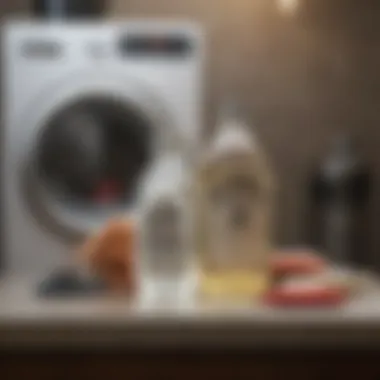Cleaning Your Washing Machine with Vinegar: A Complete Guide


Intro
Maintaining a clean washing machine is pivotal for the efficiency and longevity of the appliance. Over time, residues, odors, and grime can accumulate, affecting both the machine’s performance and the freshness of your laundry. One effective solution for tackling these issues is vinegar. This guide delves into the practicalities of using vinegar as a cleaning agent, exploring its effectiveness against common buildup and sharing essential maintenance tips.
Using vinegar not only cleans but also deodorizes your washing machine, resulting in a fresher washing experience. Understanding the science behind vinegar's properties underscores its effectiveness in breaking down difficult deposits. Additionally, the guide addresses precautions necessary to ensure safe usage while emphasizing the role of consistent maintenance in extending the lifespan of your appliance.
As we navigate through this cleaning process, expect to discover the steps required to use vinegar effectively, supplementary cleaning methods, and tips for sustaining appliance hygiene.
Understanding the Power of Vinegar
Before diving into the cleaning process, it is essential to appreciate why vinegar is a popular choice for home cleaning tasks. Vinegar is a mild acid, mainly composed of acetic acid. This quality allows it to dissolve mineral deposits, soap scum, and other residues that often accumulate in washing machines.
Benefits of Vinegar for Cleaning
- Odor Neutralization: Vinegar helps to neutralize strong odors that may linger in the drum.
- Mold and Mildew Prevention: Its antibacterial properties contribute to preventing the growth of mold and mildew.
- Descaling: Vinegar effectively combats limescale buildup, especially in areas with hard water.
"Regular cleaning with vinegar can enhance the machine's efficiency and ensure that clothes come out fresh."
Step-by-Step Guide to Cleaning
Now, let's look at the practical steps to effectively clean your washing machine using vinegar.
- Prepare Your Machine: Empty the washing machine entirely. Ensure there are no clothes or other items inside.
- Add Vinegar: Pour two cups of white vinegar directly into the drum. For front-loading machines, add vinegar to the detergent dispenser.
- Run a Cycle: Select a hot water cycle and let the machine run empty. This process allows vinegar to circulate and work on any grime.
- Wipe Down: After the cycle ends, use a cloth soaked in vinegar to wipe down the drum, door, and other areas inside the machine.
- Final Rinse: You may run a second cycle with hot water to rinse any residual vinegar.
Precautions When Using Vinegar
Vinegar is generally safe to use; however, consider the following precautions:
- Avoid using vinegar on specific rubber components, as it can cause deterioration over time.
- Do not combine vinegar with bleach or other harsh chemicals, as this can create toxic fumes.
- Regular cleaning with vinegar should complement other cleaning materials and methods, not replace them.
This thorough approach will ensure that your washing machine remains in optimal condition, enhancing its longevity and efficiency.
Foreword to Washing Machine Maintenance
Washing machines are essential home appliances, providing convenience in maintaining cleanliness of clothes. Regular maintenance is not merely a suggestion but a necessity. Neglecting the upkeep of these machines can lead to significant issues, such as odors, mold growth, and reduced performance. This section emphasizes the importance of understanding and implementing washing machine maintenance practices, particularly when utilizing vinegar as a cleaning agent.
Importance of Regular Cleaning
Keeping your washing machine clean is key to prolonging its lifespan. Over time, detergent, dirt, and fabric softener can accumulate. This buildup may lead to a variety of problems, including clogged dispensers and bad odors. Regular cleaning helps to mitigate these risks.
Moreover, it ensures that clothes come out fresh and uncontaminated. When the drum is clean, water can circulate freely, allowing optimal washing results. Thus, investing time in maintaining a clean machine can ultimately save money on repairs and replacements.
Common Issues Faced by Homeowners
Homeowners often encounter specific problems that can stem from a lack of maintenance. Here are some common issues:
- Odor: A musty smell can develop from stagnant water and residue.
- Mold Growth: Dark, damp environments in machines can become breeding grounds for mold.
- Dispenser Blockages: Soap and fabric softener can harden and block dispensers, impacting washing effectiveness.
- Inefficient Washing: A dirty machine often leads to clothes that do not come out as clean as they should.
Addressing these issues through regular cleaning is an essential practice. By employing vinegar, one can tackle many of these challenges effectively. This guide will delve into the specifics of this process, ensuring readers understand the full benefits of washing machine maintenance.
Vinegar as a Cleaning Agent
Vinegar is a staple in many households, yet few realize its profound potential as a cleaning agent, especially when it comes to maintaining washing machines. Understanding how vinegar functions in this capacity furthers our grasp of home maintenance practices and reveals a straightforward, economical solution to common appliance issues. Vinegar’s compositional traits, along with its ability to combat both grime and odors, make it a beneficial ally in household cleaning routines.


Composition and Characteristics of Vinegar
Vinegar is primarily an aqueous solution of acetic acid, usually ranging from 4% to 8% by volume. This acidic nature gives vinegar its potent cleaning capabilities. The common types of vinegar include white vinegar, apple cider vinegar, and red wine vinegar. White vinegar, due to its high acidity and lack of additional flavors, is most effective for cleaning purposes.
Moreover, vinegar contains a variety of trace materials depending on its source. For instance, apple cider vinegar includes natural sugars and additional nutrients that can sometimes contribute to its cleaning power. However, for the purpose of washing machine maintenance, the plain white vinegar is ideal due to its simplicity and effectiveness. Its ability to break down mineral deposits and dissolve soap scum is particularly advantageous denoting its significance in keeping your appliances running smoothly.
How Vinegar Works on Grime and Odor
Vinegar’s action against grime is chiefly due to its acidity. When introduced into a dirty washing machine, it interacts with residues left from detergents and minerals. This interaction helps to dissolve and dislodge built-up grime, making it easier to rinse away. Particularly, vinegar addresses hard water deposits and mildew that could accumulate in the damp environment of a washer.
Moreover, the antibacterial properties of vinegar can help neutralize odors that tend to linger in washing machines. Through the process of cleaning, it eliminates bacterial growth that is often the root cause of these unpleasant smells. This process is essential for ensuring that fresh laundry does not carry traces of odors absorbed from the washer.
"Utilizing vinegar in your cleaning routine not only enhances appliance maintenance but also supports a healthier home environment."
By taking advantage of this readily available cleaning agent, homeowners can ensure their washing machines remain in top condition with minimal effort and cost.
How to Clean Your Washing Machine with Vinegar
Cleaning your washing machine with vinegar is an essential process many homeowners overlook. Regular maintenance of this appliance extends its lifespan and encourages optimal performance. The buildup of detergent residue, mold, and odor can heavily impact the functionality of your machine. Utilizing vinegar, a natural and effective cleaning agent, allows for not just cleaning but also maintaining a fresh smell inside the washing drum. This section will elucidate the preparatory steps and the detailed cleaning process.
Preparation Before Cleaning
Before embarking on your cleaning journey, preparation is crucial. This phase ensures you have the necessary supplies, understand the manufacturer's guidelines, and know which areas require attention.
Gathering Supplies
Gathering the right supplies is the first step. You will primarily need white vinegar, water, a microfiber cloth, and possibly baking soda. Each item plays a unique role: vinegar acts as the primary cleaning agent, while a cloth is useful for wiping down surfaces. This preparation phase prevents last-minute rushes and allows you to focus fully on the cleaning process.
The key characteristic of gathering supplies lies in efficiency. When you have everything at hand, the process becomes smoother, allowing for a thorough clean. This approach is beneficial as it sets the tone for an organized cleaning session. However, relying solely on vinegar can overlook the potential benefits of other products that may enhance the cleaning effect.
Checking Manufacturer Instructions
Every washing machine comes with specific manufacturer instructions that provide guidance on cleaning. Reviewing these documents helps avoid potential mishaps that could damage components. These instructions are beneficial as they offer tailored advice based on the machine's design.
The unique aspect of checking these instructions is that it ensures compatibility with vinegar treatment. Some machines have special components that may not react well with vinegar. Ignoring this step risks voiding warranties or causing damage, leading to costly repairs. Therefore, it is imperative to consult the guidance before cleaning begins.
Identifying Areas to Focus On
Identifying areas that require a more concentrated cleaning effort enhances the overall results. Typical focal points include the drum, detergent dispenser, and rubber seals. This strategic approach addresses specific problem zones and ensures comprehensive maintenance.
The key characteristic of focusing on areas needing attention is the targeted cleaning that occurs. This method is popular as it yields a noticeable difference in the washing machine's cleanliness and performance. The downside, however, could be that some users might neglect the broader cleaning, failing to maintain hygiene throughout the machine.
Step-by-Step Cleaning Process
Once preparations are complete, it's time to proceed with the cleaning. This segment provides a systematic approach to washing your machine with vinegar.
Running a Vinegar Cycle
Running a vinegar cycle is perhaps the most vital step in the cleaning process. Pour approximately two cups of white vinegar into the drum and start a hot water cycle. This process breaks down grime and eliminates odors effectively.
The main advantage of this step is its capability to cleanse not just the visible areas, but also the internal components like tubes and filters. It acts as a deep clean, ensuring comprehensive treatment. However, the unique feature is the acidic nature of vinegar, which while effective, may require rinse cycles depending on the manufacturer's recommendations.
Cleaning the Dispenser Drawer
Another essential area is the detergent dispenser drawer. Remove it from the machine and soak it in a mixture of warm water and vinegar. This method steers clear of stubborn buildup often found here, which can impede proper dispensing of detergent.


The important aspect of cleaning this component lies in maintaining its functionality. A clean dispenser enhances overall washing performance. However, some may find it challenging to remove certain types of dispensers, which can complicate the cleaning process.
Wiping Down Rubber Seals
Lastly, do not overlook the rubber seals around the door. These areas are prone to mold and mildew buildup. Wiping them down with a cloth dampened in vinegar solution ensures cleanliness and prevents future smells.
The significant key feature of wiping down seals is the prevention of moisture retention. Regular maintenance in this area can substantially reduce the occurrence of mold, keeping the machine in better working order. Nevertheless, users must be careful not to apply excessive pressure, as rubber seals can be easily damaged if mishandled.
Best Practices for Washing Machine Maintenance
Maintaining a washing machine is not just about keeping it clean. It involves adopting a series of best practices that ensure the appliance operates efficiently and lasts longer. Regular maintenance practices minimize the buildup of grime and mold, reduce wear on components, and enhance performance. Homeowners can prevent expensive repairs by understanding and implementing these effective strategies.
Frequency of Cleaning
Regular cleaning is crucial for a washing machine's proper functioning. A good rule of thumb is to clean the washer every month or after every 30 loads. This frequency helps remove residue that accumulates from detergents and fabric softeners. Certain factors may require more frequent cleaning, such as:
- High usage: If the machine is used daily, consider cleaning it every two weeks.
- Water quality: Hard water can leave mineral deposits, necessitating more frequent cleanings.
- Type of laundry: Washing items like towels and gym clothes can lead to higher residue accumulation.
In addition to regular cleanings, it's necessary to check for signs of corrosion or wear on parts like the rubber seals and dispensers. Act promptly on these signs to maintain the appliance's integrity.
Signs That Your Washing Machine Needs Attention
It is important to recognize indicators that a washing machine needs maintenance. Ignoring these signs can lead to bigger problems. Here are some common issues to watch for:
- Odors: A persistent musty smell can indicate mildew or mold buildup inside the drum or rubber seals.
- Unusual noises: Clanking, rattling, or squeaking noises can signal mechanical issues or foreign objects caught in the washer.
- Poor drainage: If water remains in the tub after a cycle, there is potentially a blockage or pump issue.
- Inconsistent washing: Clothes coming out still stained or not cleaned properly suggest that the washing cycle isn't functioning as it should.
"Regular maintenance leads to a longer lifespan of washing machines and less hassle in the long run."
Addressing these signs promptly can save homeowners time and money in repairs. By focusing on both the frequency of cleaning and being attentive to vital signs, homeowners can enjoy the benefits of a well-maintained washing machine.
Potential Risks and Precautions
Understanding the potential risks and necessary precautions when cleaning your washing machine with vinegar is crucial. While vinegar is an effective and eco-friendly cleaning solution, improper use can lead to issues that might negate its benefits. Therefore, awareness of specific elements can increase the effectiveness of your cleaning routine and ensure the longevity of your appliance.
Avoiding Damage to Components
When utilizing vinegar for cleaning, it’s essential to consider the materials and components of your washing machine. Vinegar's acidic nature can be harsh on certain materials. For example, if your washing machine has rubber seals, frequent exposure to vinegar might cause these components to deteriorate over time, leading to leaks.
It is advisable to:
- Conduct a manufacturer check: Before starting your cleaning, always refer to the manufacturer’s instructions. Some washers may advise against using vinegar altogether or recommend the frequency of use.
- Dilute the vinegar: Instead of using undiluted vinegar, consider diluting it with water. This decreases its acidity and reduces the risk of damaging sensitive parts.
- Limit usage: Use vinegar as part of a regular maintenance routine rather than a frequent fix. This approach minimizes any potential impacts on the machine's components.
Health Considerations
While vinegar is typically safe for household use, it’s important to recognize that it can still pose health risks if used carelessly. The strong smell of vinegar may irritate some individuals, especially those with respiratory problems or allergies.
When cleaning with vinegar, consider the following precautions:
- Ensure ventilation: Always clean in a well-ventilated space. Open windows or use fans to circulate air and dissipate the strong scent.
- Protective gear: If you're sensitive to strong odors, consider wearing gloves and a mask while handling vinegar. This will help safeguard your skin and respiratory health.
- Storage safety: Store vinegar out of reach of children and pets. Though it is often considered safe, ingesting vinegar can cause health issues, particularly in large amounts.
"Regular maintenance, including careful attention to cleaning agents, leads to a more efficient washing machine."
By staying informed about these risks and precautions, you can facilitate a safe and effective cleaning process, ultimately enhancing the longevity and performance of your washing machine.


Alternative Cleaning Methods
In the realm of washing machine maintenance, understanding alternative cleaning methods is crucial. While vinegar is a renowned natural cleaner, exploring other viable options can enhance the effectiveness of your cleaning routine and address different types of residues or buildup. This section delves into two primary alternatives: commercial cleaners and the combination of baking soda with vinegar. Each method offers unique benefits and considerations.
Commercial Cleaners vs Vinegar
When comparing commercial cleaners to vinegar, it is essential to consider their formulation and purpose. Commercial cleaners often contain powerful surfactants, enzymes, and added fragrances that promise a deep clean. They can effectively target stubborn stains and unwanted odors. However, there are drawbacks.
- Cost: Many commercial products can be expensive and may lead to continuous spending.
- Chemical Exposure: These cleaners often include chemicals that can irritate skin or respiratory systems and may not be eco-friendly.
Conversely, vinegar serves as a natural alternative with acidic properties that helps break down mineral deposits and eliminate odors. It is cost-effective and less likely to contribute to indoor air pollution. However, vinegar might not perform well on some heavily soiled loads that require specialized treatment or stain removal. Additionally, some users might find its scent less pleasant compared to the fragrances in commercial cleaners.
In summary, while commercial cleaners provide convenience and targeted action, vinegar stands out for its affordability and eco-friendliness. Both methods have their own place in cleaning regimens, and homeowners should evaluate their own cleaning needs to determine the best method.
Using Baking Soda in Combination with Vinegar
Utilizing baking soda alongside vinegar can amplify the cleaning process significantly. The combination creates a chemical reaction that effectively tackles grime and buildup. Baking soda, being a mild alkaline substance, aids in deodorizing and breaking down grease and stains. Here’s how they work together:
- Natural Cleaning Power: When vinegar and baking soda are mixed, they create carbon dioxide gas, which can help dislodge debris quickly.
- Odor Neutralization: Baking soda neutralizes unpleasant smells, enhancing the freshness of your washing machine.
- Surface Scrubbing: Baking soda can act as a gentle abrasive, perfect for scrubbing down rubber seals and surfaces without causing damage.
To make the most of this combination, start with two cups of vinegar poured directly into the drum. Add half a cup of baking soda and run a hot cycle. This process cleans not only the drum but can also benefit the internal components by dislodging built-up debris. After the cycle, it’s advisable to wipe down any remaining residues.
Impact of Maintaining a Clean Washing Machine
Maintaining a clean washing machine is essential for several reasons. By understanding how regular cleaning affects your appliance, you can ensure its optimal performance and longevity. A washing machine is an investment, and like any valuable asset, it requires care to function effectively over time. This section covers the impact of a clean washing machine on longevity and efficiency, providing you with insights into the importance of these maintenance practices.
Longevity of Appliances
A clean washing machine typically lasts longer than one that is neglected. Cleaning it regularly minimizes wear and tear, especially on key components such as the drum, seals, and hoses. Grime, mold, and detergent residue can accumulate, leading to corrosion or blockage in the plumbing system. Over time, neglecting these factors can cause breakdowns, which often require costly repairs or, worse, complete replacement of the unit.
Here are some benefits of maintaining cleanliness:
- Reduced Risk of Breakdowns: Regular cleaning helps prevent malfunctions in critical parts.
- Prolonged Lifespan: A well-maintained machine can function efficiently for years beyond its expected lifespan.
- Cost-Effectiveness: Extended longevity means potentially saving significant funds that would otherwise be spent on repairs or new machines.
Improved Efficiency and Performance
A clean washing machine is also crucial for optimal efficiency and performance. When dirt and residue build-up, the machine has to work harder to clean clothes effectively. This extra strain can lead to increased energy usage, ultimately impacting your utility bills.
Some points to consider in this context include:
- Water Usage: Clogged components may decrease the machine's ability to drain water effectively, causing it to consume more water to achieve desired results.
- Wash Quality: Residue build-up may lead to undesirable odors or even transfer residues back to clothes during washing.
- Time Efficiency: A machine that runs efficiently saves time, completing cycles in a timely manner, allowing more laundry to be done.
"Regularly cleaning your washing machine not only ensures it runs smoothly but also guarantees that your laundry comes out as clean and fresh as possible."
Culmination and Final Thoughts
Cleaning your washing machine is often overlooked, yet it is essential for maintaining not just the machine itself but also the quality of your laundry. This article highlights the practical effectiveness of vinegar as a cleaning agent. Vinegar is versatile, simple to use, and environmentally friendly, which makes it an excellent option for homeowners looking to sustain their appliances without resorting to harsh chemicals.
Recap of Vinegar’s Benefits
Vinegar has several properties that contribute to its effectiveness as a cleaning agent:
- Antimicrobial Properties: Vinegar can help to kill bacteria and mold, which can accumulate in damp areas of the washing machine.
- Odor Neutralization: Its acetic acid content aids in neutralizing unpleasant odors, which are often stubborn and persistent.
- Removal of Mineral Deposits: Vinegar effectively dissolves mineral buildup, especially in machines that use hard water, thus enhancing the performance and lifespan of the appliance.
- Cost-Effective: Using vinegar is inexpensive compared to commercial cleaning products, allowing for economical maintenance.
- Eco-Friendly: It is biodegradable and thus a safer choice for the environment.
Encouraging Sustainable Home Practices
Maintaining a clean washing machine aligns with sustainable practices. Homeowners can minimize their reliance on chemicals, reducing their environmental footprint. Here are some suggestions for integrating sustainability into home cleaning routines:
- Regular Maintenance: Clean your washing machine every month. It avoids accumulation of dirt and helps in preventing larger issues.
- Use Natural Cleaners: Focus on using items like vinegar and baking soda. They are often cheaper and less harmful than commercial products.
- Educate Family Members: Encourage everyone in the household to be mindful of cleanliness to prolong the life of the appliance.
- Proper Disposal: Ensure that any cleaning materials used are disposed of correctly.
By cleaning your washing machine with vinegar regularly, you can ensure its efficiency and longevity. This simple practice can lead to improved performance, better hygiene in your laundry, and a sustainable approach to home maintenance.







